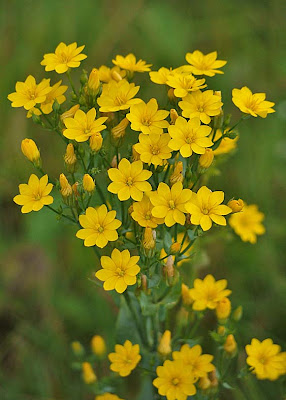If you let it, taking an interest in natural history could be very depressing because so much that is written about our flora and fauna in the press seems to be unrelenting bad news. The abysmal weather in the early part of this summer produced also sorts of hyperbolic headlines of the disastrous/cataclysmic/catastrophic kind about its likely impact on birds/butterflies/insects and almost everything else in the natural world - and it's undoubtedly true that it has been a bad summer for all of these (although it's important to bear in mind that over last few thousand years there have been periods of far more adverse climatic conditions that our wildlife experienced and rebounded from: like investments, rates of growth in populations of living organisms can go down as well as up, all the time). The natural world isn't a natural history museum, it's a living, constantly evolving interplay between organisms.
Anyway, last weekend we happened to notice a positive effect of the wet early part of the summer, when we took a walk along the cliff tops between Dawdon and Hawthorn Dene on the Durham Coast Heritage Path. The summer wild flowers there seem to be flowering more spectacularly than I can ever remember. I have a theory as to why this might be so, and it's all down to the rain.
The cliffs are porous magnesian limestone which is free-draining. In a 'normal' summer the surface soil dries out quickly and the plants suffer from moisture stress, so they flower quickly while they have the chance, when they are quite small. This year, with plenty of water, the well-watered vegetation is unusually lush and as a result the flowers are truly spectacular. So, without further ado, here are some examples....
Drifts of meadowsweet in the gullies on the cliffs and ....
.... forming a backdrop for devil's bit scabious which .....
...... includes some exceptionally fine examples ..... although this one looks a tad unusual - very short bracts under the inflorescence and it looks like it might be male-sterile, judging by the tiny stamens.
... along with field scabious .....
... flowering in profusion in the meadows at the end of Hawthorn Dene ...
... where there are some fine specimens of giant bellflower.
I suspect that alkaline soil might be the reason for the very blue hue of the tufted vetch on the cliffs but ....
... this unusually pale betony plant (normal flower behind) is probably a genetic mutation.
Bloody crane'sbill always puts on a good show ....
.... and this year centaury has done well too, with some very floriferous plants ...
This is hemp agrimony .....a major constituent of the taller vegetation while .....
.... hoary plantain is blooming down amongst the grasses.
Plenty of knapweed Centaurea nigra, alongside the ....
.... greater knapweed Centaurea scabiosa.
Drifts of marjoram aka oregano (crush the leaves and sniff for a tantalising hint of Mediterranean cuisine!)....
Spear thistle already running to seed ....
.... likewise agrimony, producing its little bell-shaped hooked fruits ....
Yellow loosestrife ....
.... and some wonderfully robust specimens of yellow-wort, with its strange glaucous, stalkless leaves.
In dry summers yellow-wort, which is an annual, is often a stunted plant and only produces a few flowers - but this year some plants have responded to the rain with a wonderful display...
... and the North Sea provides a fine backdrop for the floral spectacle ....
..... and for haymaking ....













































Nature has a way of coping with natural phenomena. It has had some years of practise.
ReplyDeleteThanks for the yellow loosestrife. I found some the other day but the Tees flooded and washed it away. It will pop up somewhere else.
A grand post...all I have to do is put names to images.
My loosestrife had a wee red blob...yours doesn't. Odd Or wasn't mine yellow loosestrife?
Please Phil can you get rid of the daft verification....I'm an Adrian Not a Robert.
I think you've covered everything i saw down that way last week........thank's for that. A nice guided tour.
ReplyDeleteAbsolutely beautiful display, hurray for the rain!
ReplyDeleteHi Adrian, Not sure what your orange dotted one would have been. Tried removing the word verification and got an influx of unpleasant spam with dodgy links almost immediately, I'm afraid.....
ReplyDeleteGreat walk along there on a fine day, isn't it John? There are some interesting garden escapes around the quarry e.g. Fuchsia, which seems to thrive there...
ReplyDeleteIf most of the rain was restricted to the hours of darkness that would be just about perfect, wouldn't it Claire?!
ReplyDelete'Spectacular' seems the right description. I've always liked the word 'argrimony' though never thought to find out what it looks like. Now I know.
ReplyDeleteHi Lucy, it's a word to savour, isn't it. I've got agrimony growing in my garden .... it's one of those plants that I like to have around ...
ReplyDelete